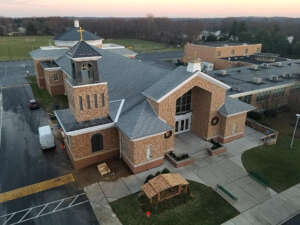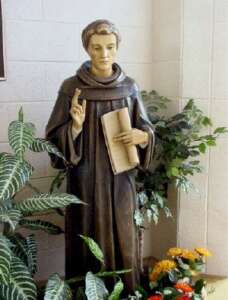Parish History
 On May 26, 1965, His Eminence John Cardinal Krol, Archbishop of Philadelphia, announced the founding of St. Bede the Venerable parish in Holland, Pennsylvania. This marked the first Catholic Church in Northampton Township. The parish was named in honor of St. Bede, an eighth century English priest. It is coincidental that the founding date of the parish is the anniversary of St. Bede’s death in 735 and both days were the same in the ecclesiastic calendar – the eve of the Ascension of Our Lord.
On May 26, 1965, His Eminence John Cardinal Krol, Archbishop of Philadelphia, announced the founding of St. Bede the Venerable parish in Holland, Pennsylvania. This marked the first Catholic Church in Northampton Township. The parish was named in honor of St. Bede, an eighth century English priest. It is coincidental that the founding date of the parish is the anniversary of St. Bede’s death in 735 and both days were the same in the ecclesiastic calendar – the eve of the Ascension of Our Lord.
The Reverend James P. Martin, an assistant pastor at St. Richard parish in Philadelphia, was chosen as founding pastor on June 9, 1965. The Decree of establishment was read at all Masses at St. Andrew parish in Newtown on Sunday, June 13, 1965.
The first general meeting of the newly formed parish was held on June 17, 1965. A lay steering committee served by several subcommittees was formed to aid in the formation of the parish. Permission was obtained from Mother M. Josepha of the Sisters of Saint Casimir, Superior of Villa Joseph Marie, for use of the school auditorium for Sunday Masses and of the school chapel for weekday masses. The first Mass in the parish was celebrated there on Sunday, June 20, 1965.
Father Martin initially resided at Our Lady of Grace in Penndel, at the invitation of Pastor Father Thomas Corrigan. After six weeks, Father Martin accepted an offer from Mr. Martin Feeney to use the house at Holland and Lower Holland Roads, now 963 Lower Holland Road. Father Albert DeCrits, CICM, professor at Archbishop Wood High School, was assigned to reside at St. Bede’s in September 1965. The rectory at 1054 Holland Road, built by Mr. John McCowan, was completed and residence established on December 11, 1965.
The paramount planning during this period was the selection of plans for the new church and school buildings. Mr. Edwin Fleming was chosen as architect and the Feasterville Construction Company, operated by Mr. William Gaul, was selected as general contractor. Ground breaking ceremonies were held on April 24, 1966. The guests of honor included presider Monsignor John J. Sefton and Mother M. Adorata, Superior General of the Sisters of St. Casimir. Work on the new buildings started on June 10, 1966.
St. Bede the Venerable School began in September 1966, with four classrooms rented from Our Lady of Good Counsel in Southampton, consisting of grades 1, 2, 4, and 6. Mother M. Josepha agreed to have the Sisters of St. Casimir staff the school. Sister M. Corinthia was assigned as first principal. The faculty consisted of Sister Infanta, Sister M. Clare, and Mrs. Dorothea Dress. Children in the remaining grades continued at St. Andrew’s.
The first Mass celebrated in the newly completed church building was on August 5, 1967, the feast of Our Lady of Snows. In September 1967, the grade school was opened for grades 1 through 7. The school was staffed by a faculty of four religious and three lay teachers.
On Sunday May 28, 1968, His Eminence John Cardinal Krol presided at the blessing of the new buildings as well as presiding at the first Confirmation ceremonies at St. Bede’s. Also on this occasion, the Cardinal granted permission to construct a convent for the Sisters.
In June 1968, Reverend Philip A. Scully was assigned as the first assistant. Work on the convent progressed rapidly, and on Christmas Day 1969, Mass was celebrated for the first time in the convent chapel.
Father Martin served as pastor for 13 years. He passed away in August 1978. Reverend William C. Faunce succeeded him and served as pastor for 8 years until his retirement in June 1986. Father Faunce passed away in September 1993.
Reverend Peter Slane was appointed pastor in June 1986. Father Slane’s significant accomplishments during his tenure included the establishment of the Parish Pastoral Council and initiating the Catholic Life 2000 program. Father Slane served as pastor for 7 years. He passed away in October 1993.
Reverend Eugene Gordon Cusick was appointed pastor of St. Bede the Venerable in June 1993. Under Father “Gordy’s” tenure, the parish built the Saint Katharine Drexel Center (housing new parish offices and meeting areas), a new school wing and a parish gymnasium. Father Gordy’s favorite achievement was the establishment of the parish’s Perpetual Adoration Chapel. Father Gordy was pastor for 12 years, until his retirement in June 2005. He remained Pastor Emeritus until his death in May 2012.
Monsignor John C. Marine was appointed the current pastor in June of 2005, by Cardinal Justin Rigali. Prior to his appointment, Monsignor Marine, a priest since his ordination in 1976, served in various parishes, then as Dean of Saint Charles Seminary and finally as the Vicar for Montgomery County. During Monsignor Marine’s tenure, the parish expanded parishioner participation through several committees, organizations and events, including the hiring of a full time youth minister, the formation of a Teen Advisory Council, Teen Choir, Evangelization Committee, CCD Advisory Board, Women’s Club, Knights of Columbus, and the annual Parish Picnic, Patriotic Concert, Padre Pio Festival and Passion Play.
In November of 2008, Monsignor Marine announced the kick-off of the Capital Campaign for a major renovation of St. Bede the Venerable Church. Over the next three years, the parishioners financially and spiritually supported the capital campaign and renovations moved forward. The unfortunate closing of Most Blessed Sacrament Parish in West Philadelphia provided St. Bede’s with invaluable artifacts and sacred art to use in the reconstruction. The interior design of the Church is so seamlessly installed that it appears that the artifacts were made for St. Bede’s. On September 24, 2011, Archbishop Charles J. Chaput O.F.M. consecrated the new St. Bede the Venerable Church.
On January 3, 2012, the Archdiocese of Philadelphia announced that Saint Bede the Venerable School was to be merged with Assumption BVM School, on the Holland campus. The patronal name of the new regional school, Saint Katharine Drexel, was chosen since the miracle that helped to bring about Saint Katharine Drexel’s canonization was received by Miss Amy Wall, a parishioner of Saint Bede Parish. Under Monsignor Marine’s leadership, the new Saint Francis Center was added to the St. Bede campus in 2015, which houses the Youth Ministry and Parish Nurse programs, as well as the first-ever Preschool.
In May 2014 Monsignor Marine announced a year-long celebration of the 50th Anniversary of St. Bede the Venerable Parish. Activities and events were conducted throughout the year that embraced the entire parish community. The Anniversary Year concluded on May 31, 2015 with Archbishop Chaput celebrating Mass in the Church followed by a parish banquet at Spring Mill Manor in Ivyland, PA.
Who Is St. Bede?
 The eighth century in English history is better known to us because of the writing of the Venerable St. Bede. If only for the worth of his history of Saxon England, St. Bede’s contribution to the world of knowledge would be formidable. He was esteemed as the most valuable contemporary historian of his time. However, his contributions extended to many other fields of knowledge — to mathematics, philosophy, music, Hagiography and Scriptures. Thus, in his own times, he was acclaimed as the most learned man, not only In England, but in all of Europe. This same acclaim was accorded him by the Church when he was proclaimed Doctor of the Church by Pope Leo III in the latter part of the eighteenth century. This was but the culmination of the honor and respect given him during the intervening thousand years.
The eighth century in English history is better known to us because of the writing of the Venerable St. Bede. If only for the worth of his history of Saxon England, St. Bede’s contribution to the world of knowledge would be formidable. He was esteemed as the most valuable contemporary historian of his time. However, his contributions extended to many other fields of knowledge — to mathematics, philosophy, music, Hagiography and Scriptures. Thus, in his own times, he was acclaimed as the most learned man, not only In England, but in all of Europe. This same acclaim was accorded him by the Church when he was proclaimed Doctor of the Church by Pope Leo III in the latter part of the eighteenth century. This was but the culmination of the honor and respect given him during the intervening thousand years.
St. Bede entered the monastery in Wearmouth at the age of seven. He remained at Wearmouth for about a year until the founding of a second monastery. St. Bede transferred to the monastery at Jarrow where he spent the rest of his life.
At the age of nineteen, St. Bede was ordained to the deaconate, extraordinary since the canonical age was twenty-five. By this time, he was already showing something of his ability as a teacher and was put in charge of the education of the oblate boys and the younger monks. By the time of his ordination to the priesthood in 703, he was already occupied with what was to be his main interest — the history of the con- version of his own people and the lives of the saints of the early English Church.
St. Bede’s title to sanctity lay not in any extraordinary deeds but in a life hidden in the cloister and devoted totally to the search for truth and the knowledge of God, the source of all truth and all knowledge. This search was to him not an end in itself, but a means whereby he would approach more nearly to God and bring others to God with him.
St. Bede was 62 years old when he died. The statue of St. Bede found in our parish center lobby represents him in the prime of his life. St. Bede’s right hand is raised in blessing — he was a priest. The scroll represents his literary activity. The glove represents his historical scholarship.
